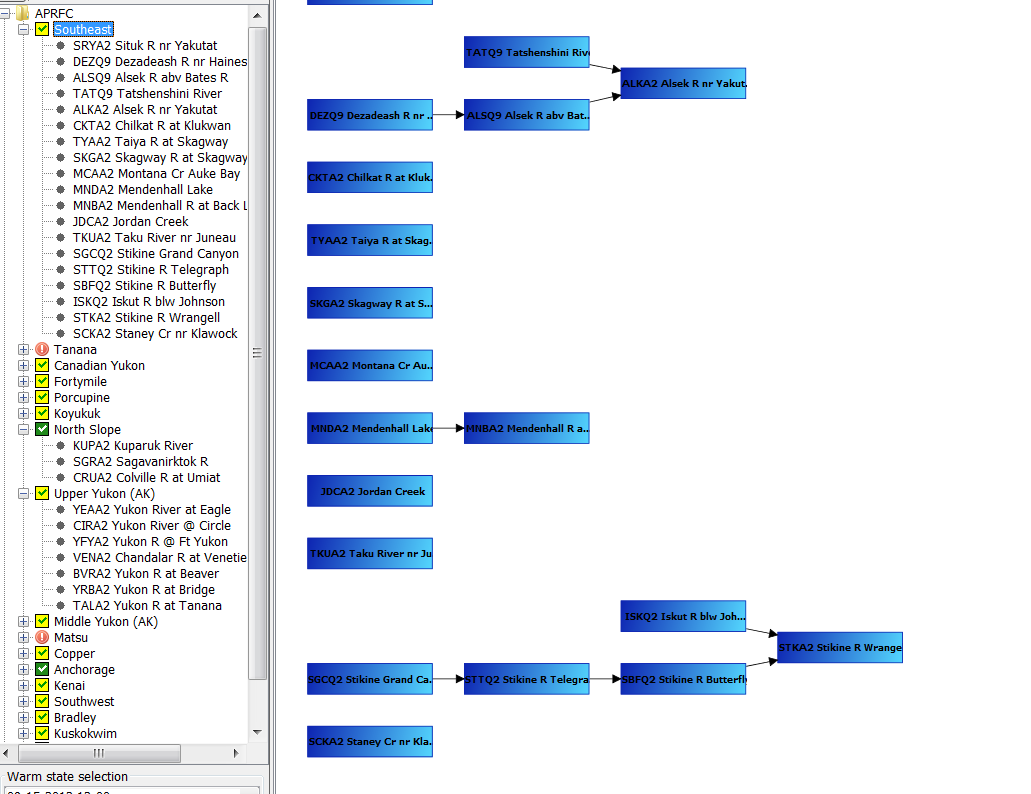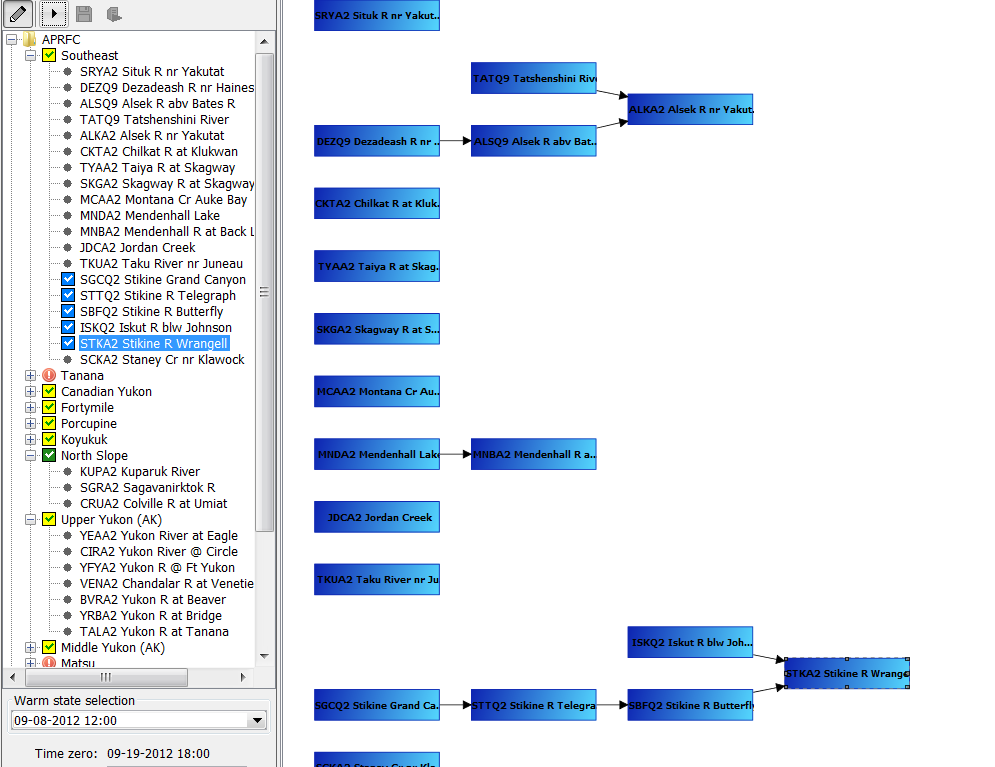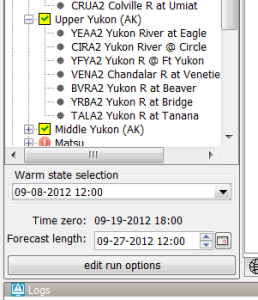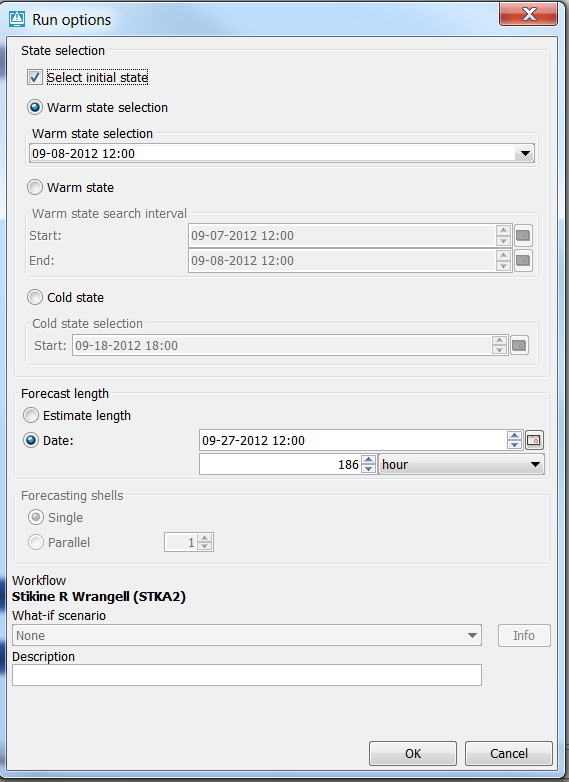...
The topology tree can be configured in the following way. The example belows show below shows a simple topology tree with two leaf nodes A and B.
...
This means that the results of the run are only temporary available in FEWS and that the results are only available visible at the stand alone or operator client which started the run. As soon as the FEWS system is restarted all the IFD runs will be deleted.
IFD runs are typically used to evaluate the effect of modifiers on the results of a forecast. A workflow which is started from a group node will by default be started as a server run. A server run will run at a FSS when it is started from an operator client. When it is started from a stand alone it will run locally but the results of the run will be available after a restart of the system.
...
It is possible to connect nodes in the topology. In the example below the node STKA2 is connect connected to two previous nodes (SBFQ2 and ISKQ2).
...
The example below shows the situation before the forecaster starts an IFD run for the node STKA2. The topology tree shows that
this node has not run yet run yet (icon is a black dot) and that it is connected to two previous nodes SBFQ2 and ISKQ2.
When the forecaster starts an IFD run for this node STKA2 FEWS will detect that it node STKA2 is connected to two other nodes which have to run to this runbefore the run for STKA2 can be started.
One of these nodes (SBFQ2) also has a previous node which has to run prior to running this node. Before running node STKA2 the IFD system will make sure that first all the necessary previous nodes are run in the correct order before node STKA2 will be run.
The example below shows the forecast tree after the run for STKA2 was finished. It shows that not only an IFD run was started for STKA2 but also for all its previous nodes.
Configuration of states, time zero and the forecast length
It is possible to manually select the task properties which will be used in the runs started from the IFD. This can be done in the panel which is shown just below the topology forecast tree. The picture belows shows an example of this panel.
The options which are shown in this panel are configurable. Each node or group of nodes in the topology can have different options.
More advanced options are available when clicking on the in the run options panel. This panel is started when the forecaster clicks on the edit run options button.
In the section below several typical configuration examples will which be desribedexplained in detail.
Warm state selection
In a lot of systems, for example NWS systems, only the state selection is configured. The time zero will in this case be equal to the system time.
...
When the system time changes the selected state will also change so the relative time compared to time zero will stay the same.
Relative period panel
When the forecaster wants to run a workflow for a certain period of time then the relative period panel is a good option to use. The picture belows shows an example of the relative period panel.
This option is used, for example, in the HERMES-system. Below a configuration example.
| Code Block |
|---|
<node id="ProcessTest" name="Process Data">
<workflowId>ProcessImports</workflowId>
<relativePeriod unit="day" start="-30" end="0"/>
<localRun>false</localRun>
</node> |
When the system time is changed then the start time and end time will also change so that the relative period will stay the same for a topology node.
Cold state from current run
To set the state selection at a node to the cold state selection which was used in another run the option coldStateFromCurrentRun can be used.
Below a configuration example
| Code Block |
|---|
<node id="rainfallpolicy_tweed" name="Set Rainfall Policy">
<workflowId>Tweed_Rainfall_Forecast</workflowId>
<coldStateFromCurrentRun>
<workflowId>Tweed_URBS_IFD_Forecast</workflowId>
<coldState unit="day" multiplier="2"/>
</coldStateFromCurrentRun>
<defaultModifierId>Rainfall Policy</defaultModifierId>
<visibleModifierGroup>URBS_Official_Rainfall</visibleModifierGroup>
<localRun>true</localRun>
<showRunApprovedForecastButton>false</showRunApprovedForecastButton>
</node> |
In the example above the cold state which was used in the current run from workflow "Tweed URBS IFD forecast" will be used.
It is possible to define a default state selection for the cases that a current run is not available yet. In the example above this default is set to a cold state selection of 2 days before time zero.
If time zero changes the cold state selection should also change to keep the relative period the same.
Overview of all the configuration options
...




